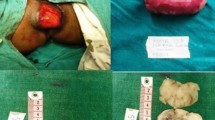Abstract
We present the case of a huge pedunculated benign mesenchymal myxoid tumor that developed on the right labia majora of a 48-year-old-woman. The excised mass weighed 4534 g and was 23 cm in diameter; the cut surface was yellowish and elastic. Microscopic examination revealed spindle and plump oval tumor cells arranged with abundant capillary vessels in an edematous stroma. Immunohistochemical staining showed that the tumor cells were positive for vimentin, desmin, estrogen receptor, and progesterone receptor, but negative for α-smooth muscle actin, CD34, CD45, CD68, and S-100. Based on these features, the pathological diagnosis was angiomyofibroblastoma. A pedunculated angiomyofibroblastoma is extremely rare and, to the best of our knowledge, this is the biggest such tumor in terms of size and weight reported to date. It is especially important in such a huge mass greater than 10 cm that angiomyofibroblastoma is differentiated from aggressive angiomyxoma, which is a deeply invasive and recurrent neoplasm.




Similar content being viewed by others
References
Granter SR, Nucci MR, Fletcher CDM (2000) Aggressive angiomyxoma: reappraisal of its relationship to angiomyofibroblastoma in a series of 16 cases. Histopathology 30:3–10
Steeper TA, Rosai J (1983) Aggressive angiomyxoma of the female pelvis and perineum: report of nine cases of a distinctive type of gynecologic soft tissue neoplasm. Am J Surg Pathol 7:463–475
Fletcher CDM, Tsang WYW, Fisher C et al (1992) Angiomyofibroblastoma of the vulva. A benign neoplasm distinct from aggressive angiomyxoma. Am J Surg Pathol 16:373–382
Omori M, Toyoda H, Hirai T et al (2006) Angiomyofibroblastoma of the vulva; a large pedunculated mass formation. Acta Med Okayama 60:237–242
Suzuki M, Hayashi T, Kohira S et al (2008) 2 cases of angiomyofibroblastoma (in Japanese). Nihon Keiseigeka Gakkaizasshi (Jpn J Plast Reconstr Surg) 28:15–23
Tochika N, Takeshita A, Sonobe H et al (2001) Angiomyofibroblastoma of the vulva: report of a case. Surg Today 31:557–559
Nielsen GP, Young RH, Dickersin GR et al (1997) Angiomyofibroblastoma of the vulva with sarcomatous transformation (Angiomyofibroblastoma). Am J Surg Pathol 21:1104–1108
Sasano H, Date F, Yamamoto H et al (1997) Angiomyofibroblastoma of the vulva: case report with immunohistochemical, ultrastructural and DNA ploidy studies and a review of the literature. Pathol Int 47:647–650
Begin LR, Clement PB, Kirk ME et al (1985) Aggressive angiomyxoma of pelvic soft parts: a clinicopathologic study of nine cases. Hum Pathol 16:621–628
Nucci MR, Weremowicz S, Sornberger K et al (1999) Chromosomal translocation t(8;12) induces aberrant HMGIC expression in aggressive angiomyxoma of the vulva. Mod Pathol 12:700
Hess JL (1998) Chromosomal translocation in benign tumors: the HMGIC proteins. Am J Clin Pathol 109:251–261
Fetsch JF, Laskin WB, Lefkowitz M et al (1996) Aggressive angiomyxoma. A clinicopathologic study of 29 female patients. Cancer 78:79–90
Mortele KJ, Lauwers GJ, Mergo PJ et al (1999) Perineal angiomyofibroblastoma: CT and MRI findings with pathologic correlation. J Comput Assist Tomogr 23:687–689
Jeyadevan NN, Sohaib SAA, Thomas JM et al (2002) Imaging features of aggressive angiomyoma. Clin Radiol 58:157–162
Skalli O, Schurch W, Seemayer T et al (1989) Myofibroblasts from diverse pathologic settings are heterogeneous in their content of actin isoforms and intermediate filament proteins. Lab Invest 60:275–285
McCluggage WG, Patterson A, Maxwell P (2000) Aggressive angiomyxoma of pelvic parts exhibits oestrogen progesterone receptor positivity. J Clin Pathol 53:603–605
Laskin WB, Fetsch JF, Tavassoli FA (1997) Angiomyofibroblastoma of the female genital tract: analysis of 17 cases including lipomatous variant. Hum Pathol 28:1046–1055
MacLean AB, Nicol LA, Hodgins MB (1990) Immunohistochemical localization of estrogen receptors in the vulva and vagina. J Reprod Med 85:1015–1016
Conflict of interest statement
The authors have no conflicts of interest.
Author information
Authors and Affiliations
Corresponding author
About this article
Cite this article
Nagai, K., Aadachi, K. & Saito, H. Huge pedunculated angiomyofibroblastoma of the vulva. Int J Clin Oncol 15, 201–205 (2010). https://doi.org/10.1007/s10147-010-0026-0
Received:
Accepted:
Published:
Issue Date:
DOI: https://doi.org/10.1007/s10147-010-0026-0




